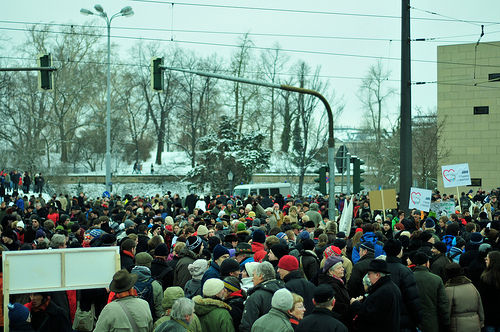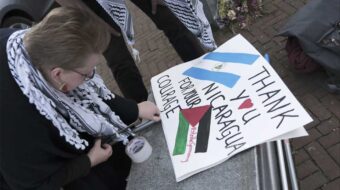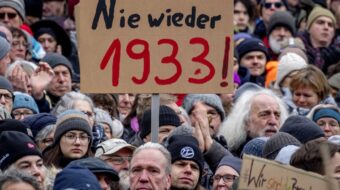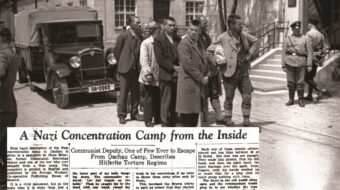
The Berlin anti-fascists waiting near the Spree River at 4:30 AM for the buses to Dresden were sleepy, cold and nervous. Not without reason. Some had faced the Nazis a year earlier. Every year these latter day storm troopers try to misuse the emotions of Dresdeners mourning the loss of 25,000 to 35 000 people in the bombing inferno which incinerated the city on February 13th 1945 by downplaying the Holocaust and Nazi crimes in general.
The antifascists always oppose them. But last year it was again they who were treated coolly by the authorities. The police took their time at the city limits frisking them for weapons and then concentrated on protecting the Nazis. While driving home, a bus load of union members was severely attacked by Nazis from Sweden; one man’s skull was fractured. The attackers have never been apprehended; the police said they were “overburdened.” And this year the Nazis threatened to break all records with 10,000 adherents from near and far. Just in case, the antifascists were given maps, telephone numbers and as well as tape for the bus windows in case stones were thrown.
They felt somewhat safer when they got moving, with 1300 people from Berlin. When buses from the state of Brandenburg joined up they formed a convoy of 30 buses for the 2-3 hour trip. The police checkup at the Dresden city limits was quicker and far less unfriendly this time. They had barely arrived when they heard calls to “Hurry up, our blockade is forming!”
Twenty-nine buses rolled in from all parts of Thuringia, others were arriving after a long night’s trip from the Rhineland, a group from Vienna had arrived a day earlier. Legislators from The Left held four “open air caucus meetings” and attracted local inhabitants; a famous leftwing singer attracted more. Before long four main groups had formed, with two to five thousand people each, waiting in the icy cold, sitting on mats, stamping their feet or sipping hot tea or soup, and effectively blocking off, from all sides, the big railroad station where the Nazis planned to start their march. Two organizations had joined and prepared this demonstration for a whole year, the main one called “Dresden -Nazi frei” (“free of Nazis”), the other using as its name the Spanish Civil War slogan, “non pasaran.”
Two very different events were planned across the Elbe River which bisects Dresden. One was the habitual ceremony at the cemetery, in front of the memorial monument to all those who died during the inferno which engulfed Dresden 65 years ago. The mayor of Dresden, the minister president of Saxony, of which Dresden is the capital, a leading rabbi and Jewish representative and other celebrities were present, but also a menacing contingent of black-clad Neo-Nazis, including some from their small but loud-mouthed caucus in the state legislature.
But this year the Dresden authorities had altered their previous attitude of routine, half-hearted opposition to the Nazis. Looking in their direction, Mayor Helma Orosz, a Christian Democrat, spoke more clearly than many other politicians in recent years:
“By working together and protesting jointly, opponents of the rightist extremists , whether they are radical leftists or Christian Democrats, antifascists or church groups, can prevent them from spreading their inhumane National Socialist ideology, their racism, anti-Semitism, their lies and their distortions of history…
“Before Dresden burned, Semper’s synagogue burned, Warsaw, Rotterdam and Coventry burned. These truths must be used in confronting these latter-day warriors. Dresden does not want them.”
Last year’s images of marching Nazis, sent out throughout the world, had evidently alarmed both Dresden’s conservative leaders as well as a large number of its citizens. In the early afternoon, it had been decided, a human chain would link the rebuilt synagogue with City Hall to demonstrate their opposition to the Nazis. There were doubts as to whether the required 5000 people would take part. But they did.
By 2 o’clock there were so many that the single chain became a double line. Then it was extended around the Old Market Square, where thousands of corpses had been collected and burned in 1945, then on to the newly-rebuilt Frauenkirche (Church of Our Lady) and the grandly rebuilt Opera House. An estimated 15,000 took part, often for the first time in such a demonstration. After the chain was dissolved some tried to cross the river to join the blockades, not easy because both a railroad bridge and some pedestrian bridges had also been blockaded.
Meanwhile tension was mounting at the railroad station, the same one from which a last group of Dresden Jews had been sent off to the death camps just before the bombing raid. Police forces, three deep, protected the Nazis when they marched from their buses to the station, though some smaller gangs vandalized through the area, attacking one left-wing youth center and injuring several of its defenders, one of them severely. There were a few minor skirmishes with less disciplined anti-fascists, the violence-prone types who join in most demonstrations. But most Nazis were finally cordoned off by the police in front of the station, impatient, angry, occasionally violent – but cornered.
Although the courts had given official permission for the Nazi march, against the protest of the city of Dresden, a police spokesman said that the force of almost 5700 in uniform, plus 1700 as reinforcements from other states, was unable to break up the blockades of the antifascists, now at least 10,000 in number, and including both elderly people and women with children. All they could do was maintain the safety of the estimated 6400 fascists in front of the station until 5 PM, when the time allotted them for their demonstration ran out, and then get them away safely.
So the crowd, overwhelmingly young, with many from The Left and from several Communist parties, also from union groups as well as some Greens and leftwing Social Democrats, waited patiently in the cold, kept their ears to their cell phones and pocket radios and waited for new developments. They cheered at 5 o’clock when the police announced that the Nazi march had been canceled but stayed on to make sure and then cheer even louder at about 7 PM when the police refused the Nazi demand to march back to their buses and loaded them instead on trains which kept them off the streets. And then, in a twitter message, the top Nazis made it official: “The mourning march did not take place.”
After a final victory meeting the demonstrators ended the ten hour blockades and headed home. It was good that the mayor and the big shots had also opposed the Nazis and that so many people in Dresden had given up their apathy and joined them. It was a surprise that this time the police had been fairer than ever before in recent years. But the real victory lay in stopping the Nazis, and just possibly making them give up Dresden marches in the future. That, the tired antifascists were convinced, as they headed for home, had been achieved by their powerful blockades.
Many of them won’t be waiting a year to demonstrate again. Only one week later, Saturday, February 20th, a demonstration is scheduled in Berlin to pressure the Bundestag and German government leaders to pull the troops out of Afghanistan.
Photo: Thousands gather in Dresden, Germany to protest a Nazi parade. http://www.flickr.com/photos/realname/ / CC BY 2.0











Comments